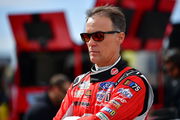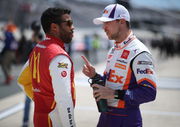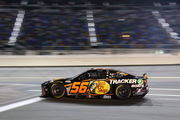
USA Today via Reuters
Apr 23, 2023; Talladega, Alabama, USA; NASCAR Cup Series driver Kyle Larson (5) NASCAR Cup Series driver Chase Elliott (9) NASCAR Cup Series driver Daniel Suarez (99) NASCAR Cup Series driver Ross Chastain (1) race at Talladega Superspeedway. Mandatory Credit: Marvin Gentry-USA TODAY Sports

USA Today via Reuters
Apr 23, 2023; Talladega, Alabama, USA; NASCAR Cup Series driver Kyle Larson (5) NASCAR Cup Series driver Chase Elliott (9) NASCAR Cup Series driver Daniel Suarez (99) NASCAR Cup Series driver Ross Chastain (1) race at Talladega Superspeedway. Mandatory Credit: Marvin Gentry-USA TODAY Sports
Sunday’s Talladega race was a record-tying spectacle with 72 lead changes, making it one of the most shuffle-heavy races in NASCAR history—second only to those tandem drafting showdowns back in 2010–11. But even with all that action, it just couldn’t keep the fans on the edge of their seats, most likely because of the slow fuel-saving strategy. In the third year of the Next Gen car era, everyone’s figured out that passing on superspeedways is tough as nails, making track position more crucial than ever.
Securing that prime spot on the track has become the name of the game, and teams have cracked the code: spend as little time as possible refueling on pit road since tires aren’t the main concern during green-flag stops. This plan has everyone driving in fuel-saving mode, which can even mean going up to six seconds slower per lap—a pace so leisurely it hardly feels like racing. Despite the snooze-fest, Brad Keselowski‘s spotter defended their strategy, explaining it’s just the state of play right now, especially as they maneuvered to counter the moves by the Chevy teams.
ADVERTISEMENT
Article continues below this ad
Brad Keselowski and his team had a dual mission: disrupt the Chevy drivers’ momentum and boost the #17 car into the lead
Explaining the on-track strategy, particularly the focus on fuel-saving, TJ Majors, Keselowski’s spotter, shared their approach. “We were trying to push cuz all the Chevys were trying to save and we’re like all right well let’s force them. Let’s force their hand to not be able to do it. So, if they’re running faster than the groups running faster than they want to run and we get away they’re going to be in trouble. What I mean is they need the group to save fuel and that group’s hauling as they got to run a certain speed so you push them to a certain speed. And um which I feel like it was going to work cuz if if we could if we could have got to second Brad [Keselowski] can we can push like we push the 17 to the lead.”
He admitted that the game plan for the RFK Racing team was to drain the Chevy drivers of fuel and push them into an uncomfortable spot. Majors believed that if they hadn’t pressured the Chevy drivers, the Ford would have been at a disadvantage from the get-go. Taking advantage of the Chevy’s struggle to stay organized, he said, “So, we got to push them and force their hand, and um we were just starting we were just starting to really take off whenever those guys decided they couldn’t stay in line.”
But it wasn’t just the Chevys feeling the heat from the Fords; the Toyotas found themselves in a pickle too. As the final stage unfolded at Talladega Superspeedway, the Toyotas decided to switch things up. While the rest of the pack dialed it back to save fuel, the Toyotas hit the pits and came out gunning to go full throttle. It didn’t take long to see just how much quicker this small group was moving compared to the fuel-conserving crowd. Their aggressive approach seemed like a winning move until everything flipped on its head.
ADVERTISEMENT
Article continues below this ad
In their bid to speed up, the racing got a bit too intense, leading to a major wipeout. Erik Jones spun out, dragging Bubba Wallace, John Hunter Nemechek, and Denny Hamlin into the chaos with a crash in turn 3. Their strategy quickly went from a stroke of genius to a complete bust. But well, for now, it looks like that’s the wild ride these next-gen cars are bringing to the superspeedway. including Talladega and Daytona
Trending
TJ Majors points out that saving fuel is just part of the game at superspeedways like Talladega these days
Fuel-saving is the harsh reality of NASCAR currently. But is there a fix for this? It’s tough to say with the Next Gen cars ruling the track. Unless NASCAR tweaks how these cars race—maybe letting drivers make moves without the risk of losing big for stepping out of line like Kyle Busch pointed out—fuel strategy is gonna stay front and center.
ADVERTISEMENT
Article continues below this ad
TJ Majors chimed in on this too. He was like, “Yeah like if we don’t save fuel we’re going to be whole like and it’s not the race’s fault. It’s the we have it’s the engineers and the teams that have figured out a way to the most efficient way and that’s the most efficient way to do it. […] I mean you’re not going as hard as you can but that’s not the fastest way to be that’s not the most efficient way to win the race [on tracks like Talladega or Daytona].”
But there could be a glimmer of hope. If NASCAR decides to shake things up—maybe by changing up stage lengths or setting minimum speed limits—it could spice things up and make races both more competitive and safer.
ADVERTISEMENT
ADVERTISEMENT
ADVERTISEMENT
ADVERTISEMENT






